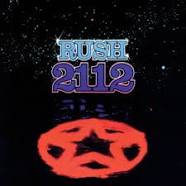20 Rush Albums in 20 Days: Roll the Bones
 DAY SIXTEEN: Rush, Roll the Bones, running time 48:04, released September 3, 1991
DAY SIXTEEN: Rush, Roll the Bones, running time 48:04, released September 3, 1991
For me, Roll the Bones is the sister of Presto, much like Hemispheres and A Farewell to Kings, Signals and Grace Under Pressure, Power Windows and Hold Your Fire, etc. It seems like Rush tends to pursue a sound for two albums and then moves onto new endeavors. Here, they continue the more prominent guitar sound (albeit trebly, crunchy guitar without much meat to it) with keyboards providing a significant bedding; it’s not yet the harder-edged full sound of Counterparts, but it’s getting there.
Gone are the days of silence between the notes. On Roll the Bones, there’s always something filling in the soundscape – a droning keyboard, the long ring of a snare’s reverb, an overdubbed guitar – a trend that started with Signals (and I’m not sure has stopped yet), and this the only part of the production that drives me a bit bonkers. A little more dynamic range and an occasional moment of silence would have been welcome.
But this is a minor quibble. Roll the Bones is an excellent album. There are Rush fans who hate this era of the band, but for me this album is smack dab in the middle of Rush’s second golden era (the first starting at 2112 and ending at Moving Pictures). You’ve got good melodies over a rocking, upbeat sound, mostly in major keys (something anathema to the band on Snakes and Arrows), but the biggest asset is Peart’s accessible, relatable lyrics. Yes, he makes the lyrical sin of rhyming “chance,” “dance” and “romance” (seriously – what’s next? Cool, fool and school? Love, dove and above?), but then he throws out gems like “Distance is a long-range filter/Memory a flickering light.” Here, Peart writes of fate, youth, chance, randomness, circumstances, love, dreams – all relatable stuff for a band that used to write about black holes, monsters and battling gods.
The rap in the title track is a lot of fun, and the band played it for many years on tour, almost to the point of being overplayed (much like “Dreamline” and “Force Ten”), but here too Alex mucks up the rap by playing lead guitar over it. Silly. “Bravado” and “Heresy” are fantastic slower songs with terrific messages, and the chorus of “Ghost of a Chance” is as close to adult contemporary that the band has ever come (and you know what? It’s fricking good). Rush wisely limits the album's length to 48 minutes plus, a full four minutes less than Presto. Even still, the album loses some of its momentum with the final two tracks, “Neurotica” and “You Bet Your Life.” Still decent songs, however, and when push comes to shove, Roll the Bones is on par with Presto, which for me means definitely in the top ten albums that Rush has produced.
Oddly, selections from this album have been hard to come by live. Only five tracks were played on the Roll the Bones tour, and since then, only three have made it into the rotation. I would love to hear “Heresy” or “The Big Wheel” live – something other than the first three tracks – but as usual Rush leans on familiar ways.
Tomorrow, I’ll be listening to…drum roll, please…number 5, A Farewell to Kings. This album had me mesmerized when my brother purchased what I remember to be a cutout of this 1977 release. We’ll see if it still has the magic.



